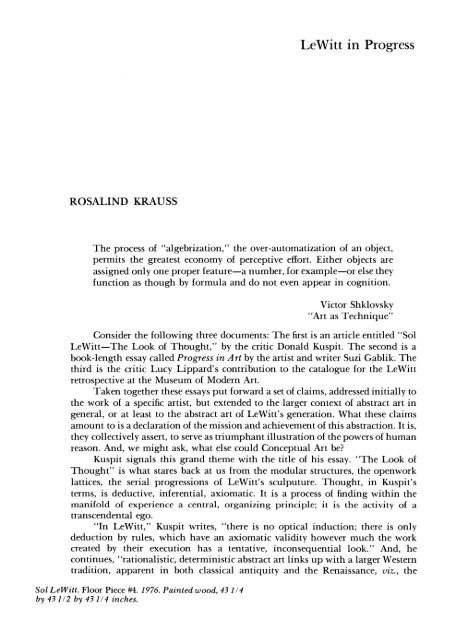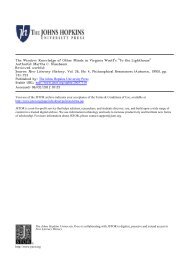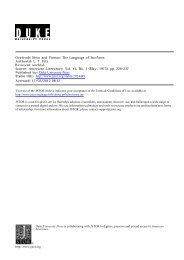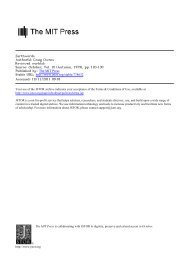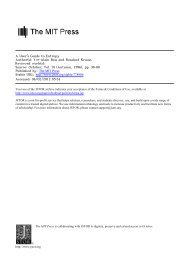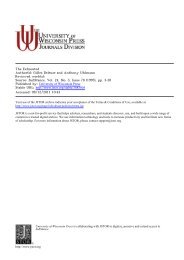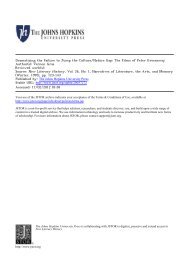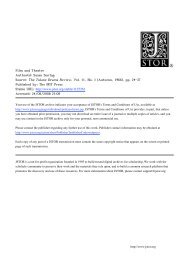Krauss-LeWitt in Progress - engl328
Krauss-LeWitt in Progress - engl328
Krauss-LeWitt in Progress - engl328
Create successful ePaper yourself
Turn your PDF publications into a flip-book with our unique Google optimized e-Paper software.
ROSALIND KRAUSS<br />
<strong>LeWitt</strong> <strong>in</strong> <strong>Progress</strong><br />
The process of "algebrization," the over-automatization of an object,<br />
permits the greatest economy of perceptive effort. Either objects are<br />
assigned only one proper feature-a number, for example-or else they<br />
function as though by formula and do not even appear <strong>in</strong> cognition.<br />
Victor Shklovsky<br />
"Art as Technique"<br />
Consider the follow<strong>in</strong>g three documents: The first is an article entitled "Sol<br />
<strong>LeWitt</strong>-The Look of Thought," by the critic Donald Kuspit. The second is a<br />
book-length essay called <strong>Progress</strong> <strong>in</strong> Art by the artist and writer Suzi Gablik. The<br />
third is the critic Lucy Lippard's contribution to the catalogue for the <strong>LeWitt</strong><br />
retrospective at the Museum of Modern Art.<br />
Taken together these essays put forward a set of claims, addressed <strong>in</strong>itially to<br />
the work of a specific artist, but extended to the larger context of abstract art <strong>in</strong><br />
general, or at least to the abstract art of <strong>LeWitt</strong>'s generation. What these claims<br />
amount to is a declaration of the mission and achievement of this abstraction. It is,<br />
they collectively assert, to serve as triumphant illustration of the powers of human<br />
reason. And, we might ask, what else could Conceptual Art be?<br />
Kuspit signals this grand theme with the title of his essay. "The Look of<br />
Thought" is what stares back at us from the modular structures, the openwork<br />
lattices, the serial progressions of <strong>LeWitt</strong>'s sculputure. Thought, <strong>in</strong> Kuspit's<br />
terms, is deductive, <strong>in</strong>ferential, axiomatic. It is a process of f<strong>in</strong>d<strong>in</strong>g with<strong>in</strong> the<br />
manifold of experience a central, organiz<strong>in</strong>g pr<strong>in</strong>ciple; it is the activity of a<br />
transcendental ego.<br />
"In <strong>LeWitt</strong>," Kuspit writes, "there is no optical <strong>in</strong>duction; there is only<br />
deduction by rules, which have an axiomatic validity however much the work<br />
created by their execution has a tentative, <strong>in</strong>consequential look.' And, he<br />
cont<strong>in</strong>ues, "rationalistic, determ<strong>in</strong>istic abstract art l<strong>in</strong>ks up with a larger Western<br />
tradition, apparent <strong>in</strong> both classical antiquity and the Renaissance, viz., the<br />
Sol <strong>LeWitt</strong>. Floor Piece #4. 1976. Pa<strong>in</strong>ted wood, 43 1/4<br />
by 43 1/2 by 43 1/4 <strong>in</strong>ches.


